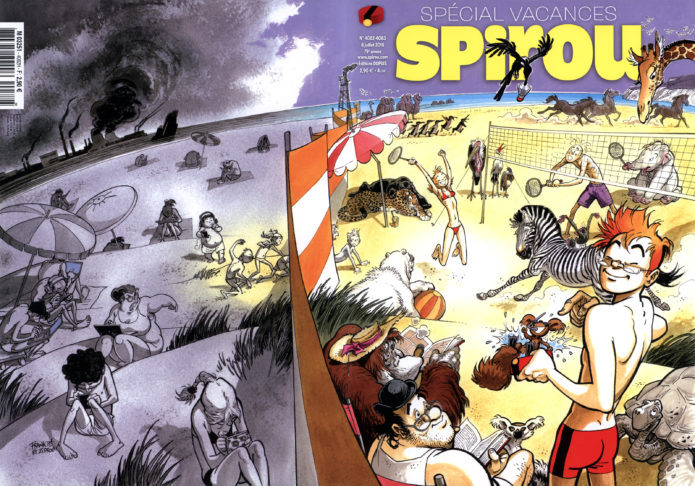
This week the special 100-page summer issue of the Journal de Spirou (#4082–4083) is out, featuring the first installment of La Lumière de Bornéo (“The Light from Borneo”) by Frank Pé & Zidrou. (A sample of the issue, as well as a preview of the following issue, is available on Izneo.) All the pages thus available have already been seen in Frank’s inks, but now we have the final version in beautiful color (by Cerise).
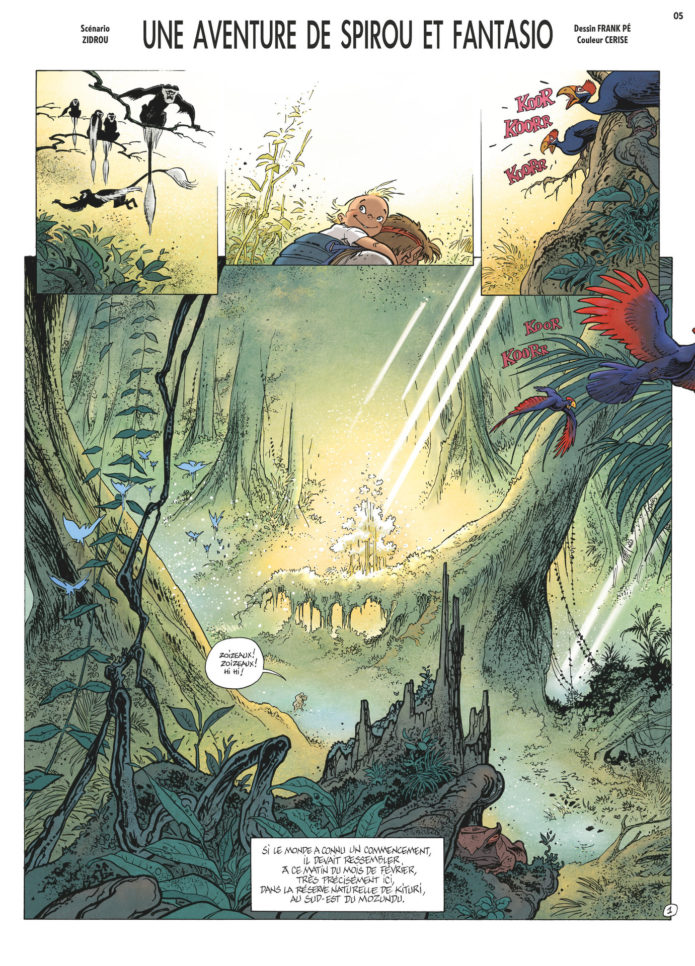
After a prologue set in the African jungle (perhaps in Borneo, though the location is given only as “Kituri nature reserve, South-East Mozundu” – apparently a made-up place), the story opens with Spirou and Fantasio (slightly older than we’re used to seeing them) working as investigative reporters for the Moustique. However, when their editor wants to tilt a story to be more favorable to one of the magazine’s advertisers, a big international conglomerate, Spirou resigns in outrage. Thinking he’ll take some time off just enjoying life, he decides to take up painting as a hobby. Meanwhile, a mysterious artist is sending gorgeous canvases to a Brussels art gallery, and the Count of Champignac discovers an unknown mushroom.
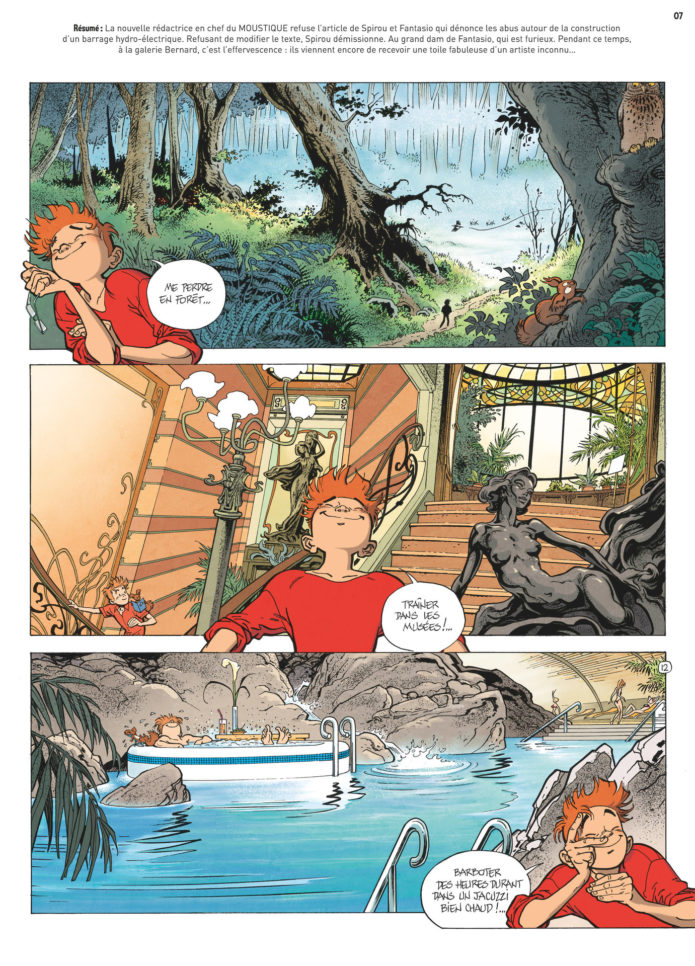
Each issue also features part of an interview with Frank Pé by Hugues Dayez:
Frank Pé: “What matters about Spirou is me being in tune with Franquin.”
He’s one of the Journal’s leading comics creators, but he’s rarely been seen in the pages of the magazine lately: Frank Pé makes a grand reentrance with “The Light from Borneo”, an original Spirou adventure made in collaboration with Zidrou.
What made you want to get involved with the magazine’s founding hero, who’s already been through the hands of so many different creators?
Frank: What motivated me about the series was precisely how foundational it is, but in the sense that it’s the foundation of my own course in life: Franquin is the creator who more or less opened my eyes to comics, with an openness of the heart that has stayed with me to this day, and that has only grown stronger over the course of the years. The desire to do a Spirou has always tempted me, but humility quickly got in the way, you know! I had to wait until I was almost sixty to tell myself, “Go on! Maybe now I’ll dare to do it!” Particularly since it’s not about “doing Franquin”, but simply doing Spirou my way. That freed me. I told myself, “I can do that!”
You mention Franquin, but many things have happened to the series since Fournier took over in 1968… Did the different teams that have worked on the series help you relax about the responsibility of drawing Spirou?
Frank: Actually, that’s been pretty far from my thoughts, because the thing that matters to me about Spirou is me being in tune with Franquin. I immediately asked myself this preliminary question, “What does it mean to draw a Spirou story?” When Franquin did it, he was making a positive hero for everyone, grounded in the present-day. That’s the definition I took up: What does it mean to me, in 2016, to create a believable, positive character who speaks to today’s readers? That’s how I avoided the risk of falling into imitation and nostalgia, or to be bogged down by what others have done. No, I’m taking the bull by the horns – and it’s a great challenge to try to make something for a wide audience; no easy task!
You begin your story with a prologue set in the wilderness. Is this a deliberate way to put your own stamp on it and to reaffirm the ecological themes that run through all your work?
Frank: No, not at all. And actually, more than an environmentalist, I’m an animal-lover. And if that comes up again and again in my work, it’s because it’s always at the back of my mind, it’s not something I insert deliberately. And if the question appears in Spirou, it’s because the story was conceived as a modern adventure for a wide audience. And it seems to me that this theme – what humanity is doing to the Earth – is one of the most urgent and essential of our age, and I wanted to deal with it head-on. Readers will discover it in the course of the story: even if it begins in the African jungle, it’s really the relationship between man and nature that is the central question of this album. I definitely wanted to address important issues. I hate the idea of a story as “diverting”. It literally means that it pulls people away from what’s important. My goal is the opposite: to bring them back to what matters, with pleasure and heart.
The next thing we’re introduced to is the Moustique offices and “your” Spirou and Fantasio. Did you make a lot of sketches to get a grip on the characters?
Frank: I asked myself a lot of questions. But I didn’t make a ton of character studies. I don’t draw compulsively! But I’m always trying to find something that fits right. As soon as I’ve found it, I jump straight to the comics page. So I do as few exploratory sketches as possible, so that it really comes alive in my pencil: the creativity happens on the actual page, not in the preparatory sketches. I’m convinced that the reader can sense that. I sense it with a jazz singer like Mélanie De Biasio: on stage, she improvises every concert! She just dives in, and what emerges [in the music] is alive, because of the risk she’s taking… I feel the same way when I throw myself into the page.
Frank: “It’s a Spirou story that’s quite politically engaged!”
Times are tough: Le Moustique refuses to publish an investigation by Spirou and Fantasio out of fear of offending their advertisers… In reaction, Spirou spontaneously quits, and seriously plans to take time off! A real upheaval for the intrepid hero!
You chose to make Spirou a reporter for the Moustique, like Fantasio… But he has more integrity than his friend. How did you get this idea?
Frank: Because it seemed to me that Spirou, like the heroes of our age, would necessarily feel indignation! If you’re going to have a hero today, he has to be, to some extent, looking for solutions to all the problems created by the “Big Brother” system we all live under… So Spirou naturally comes into conflict with a multinational corporation, with the forces that destroy nature, with Big Money… In that sense, it’s a Spirou story that’s rather politically engaged, but I had the good fortune to be working with Zidrou, who made it light and funny enough that I don’t think the story suffers from the heavy earnestness of “an important message”! It’s not meant to be a political tract or a manifesto: it’s meant first of all as a fun story!
How did you work with Zidrou?
Frank: I started off trying to write the script by myself. But not being a professional writer, I felt that my story wasn’t all that good. I asked Zidrou to led me a hand, because he has, to my mind, all the skills that I lack, both in terms of his sensibilities and his technique, to take my first draft and rewrite it his way. We spent a few evenings together, I told him my outline, what I wanted, what my motivations were when it came to this project; he went back home, and three weeks later, I received the finished manuscript. From page 1 to page 84, it was perfect! When I saw him again, I could tell him that he’d understood me perfectly. It was great!
You’ve moved from Brussels to the Namur region, but there are lots of references to Brussels in your backgrounds: the Halles Saint-Géry market, the Galeries Saint-Hubert arcade…
Frank: Yeah! Since this story takes place in the near future, Brussels is a great setting, because it’s a city that evolves a lot. It’s very anarchic, very chaotic, and much more interesting in my opinion than Paris, which is more of a “museum town”. So I grabbed hold of Brussels with both hands again. At one point, readers will discover the Atomium in a rather bizarre way – I’ll say no more! It’s a way to work with architectural symbols from Franquin’s period. In drawing this album, I had Franquin looking over my shoulder, but also all these references from my parents’ generation. It’s always exciting to recreate the world you were born and grew up in…
The challenge with a one-shot is how to harmonize all your interests and ambitions with Spirou and Fantasio, isn’t it?
Frank: Oh, that’s impossible! To put all you love about the series into a single adventure! The thing I cared most about was to work with the character Noé (Noah), from Bravo les Brothers (“The Bravo Bros.”). To me, he’s the most appealing character in the entire Franquin universe, because he has a serious side that is rare to find in his work. I have the feeling that Franquin identified quite a lot with this character. Noé is a genius, and he knows it; he has an exceptional knack with animals, and at the same time he can’t get along with his own kind, and avoids them as much as possible… To the point where you have to wonder what this guy’s story is! That was my starting point for the story: to try to discover the past of this ordinary little guy who has this amazing gift!
Visually, you’re drawing a character who’s a lot bigger and heavier than Franquin’s.
Frank: I’ve had him get older, evolve… I admit that it’s a bit of a cheat: I simply wasn’t able to draw him in my semi-realistic style. He has a pear-shaped head and a long nose, and I couldn’t find a realistic version of that: he always turned out grotesque. So I decided that I would take the essence of his personality and draw him my own way. Even if he doesn’t look exactly the same, I wanted to get him right on the psychological level. And, to repeat: this is the near future – years have passed. Noé has gotten older, he’s gained a few kilos. His lifestyle isn’t particularly healthy: he stays in his little trailer gorging himself on canned food, so he’s gained some weight. There you go!

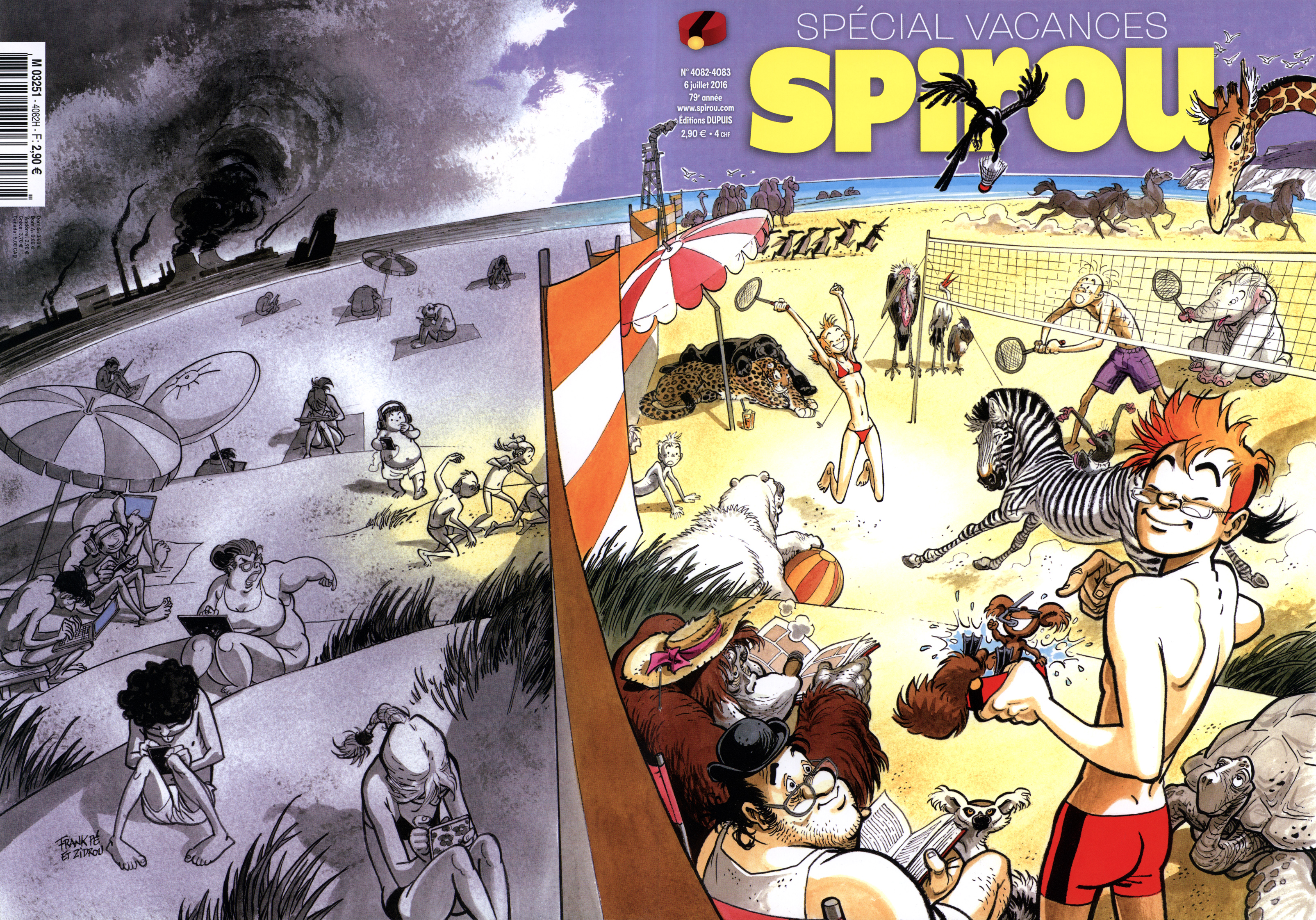
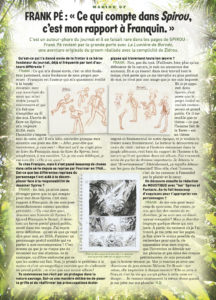
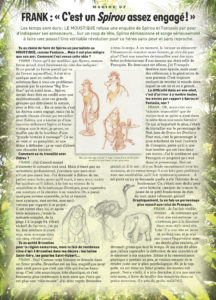
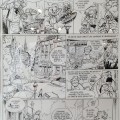
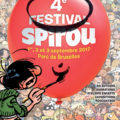

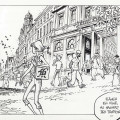
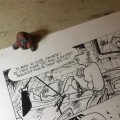
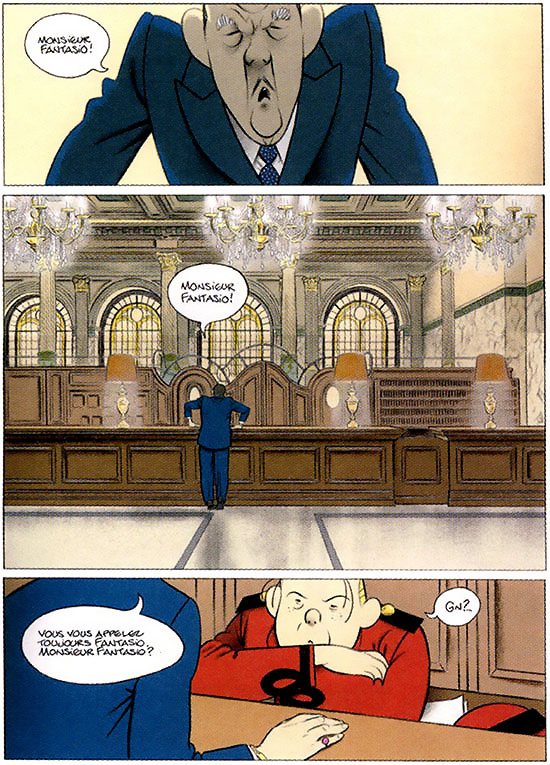


Borneo is, of course, not in Africa, so if the comic opens in “an african jungle”, it cannot be in Borneo then.
D’oh! I was thinking of Madagascar! >:(
… and I think I just figured out the title, so I won’t be making that mistake again. (SPOILER)
.
.
.
.
.
.
.
.
.
.
.
.
.
.
.
.
What comes from Borneo? Orangutans, as the one seen here on the magazine cover. And who’s the master whose paintings are sent anonymously to art galleries? Paintings that seem to SHINE with light? … Should this MAYBE remind us of something?
Spoiler?
IGtyk CatSpirou liked this on Facebook.
Kalle Id liked this on Facebook.
Akane Varkos liked this on Facebook.
Michel Demoustier liked this on Facebook.
Jan Erik Lehn Kaya liked this on Facebook.
Inês Santos Saraiva liked this on Facebook.
Juanjo Rodríguez liked this on Facebook.
Helge Kvingedal liked this on Facebook.
Oky Divi Ramdhani liked this on Facebook.
Frode Kahrs Ormberg liked this on Facebook.
Bernardita Martínez Martínez liked this on Facebook.
Emily Stewart liked this on Facebook.
This wraparound cover makes me think of Jijé’s Summer Holiday cover for the magazine made nearly 60 years ago.
http://www.spirou.free.fr/images/1004.jpg
That’s very nice, thanks! I’m surprised to see Jijé was drawing generic covers as late as 1957; I would have thought that would fall on Franquin.
I think I like this one better than Frank’s because the kids are getting into all kinds of trouble on their vacation: falling out of trees, choking on smoke, knocking their heads and almost drowning in the river, etc. It complicates the boring=bad / fun=good dichotomy and makes it more interesting, while this week’s cover feels a bit heavy-handed in its message. Maybe if some of the wild animals were chasing some of the kids…
Ah, yeah… Freedom trumps safety, perhaps…
This was a special event, I think… Jijé weren’t doing covers like that often at that time…
I really like what I have seen so far! As for the rainforest in Mozondu, I can only hope that it does take place in Africa since the birds shown are pretty clearly touracos and those are endemic to the continent. Also, there are colobus monkeys which are also exclusively African. Seeing how accurate to life both are drawn one can only hope the authors were as vigorous in terms of biogeography as to anatomy (and Madagascar too would be awfully wrong: no colobus monkeys or touracos there). Or at least, I would hope so but I’m probably in the minority. For what it’s worth, the name Mozondu certainly sounds more African than Asian to me.
On the whole, this certainly seems like one of the better one-shots. I quite like the bittersweetness that is suggested.
There’s no reason to doubt that the setting is continental Africa: Borneo and Madagascar only came into the discussion through my misunderstanding. I’m now convinced that the title is a reference to the orangutan seen on the cover, clearly one of Noé’s extraordinary animal friends.
(I also think the skinny girl playing badminton with Fantasio is the baby from the prologue, grown up.)
So far I like it a lot, too. I’m not quite sure Spirou and Fantasio are 100% in character – I’ve seen some comments that Spirou seems to be “over-acting”, and I can see where that’s coming from – but other than that the opening is extremely promising.